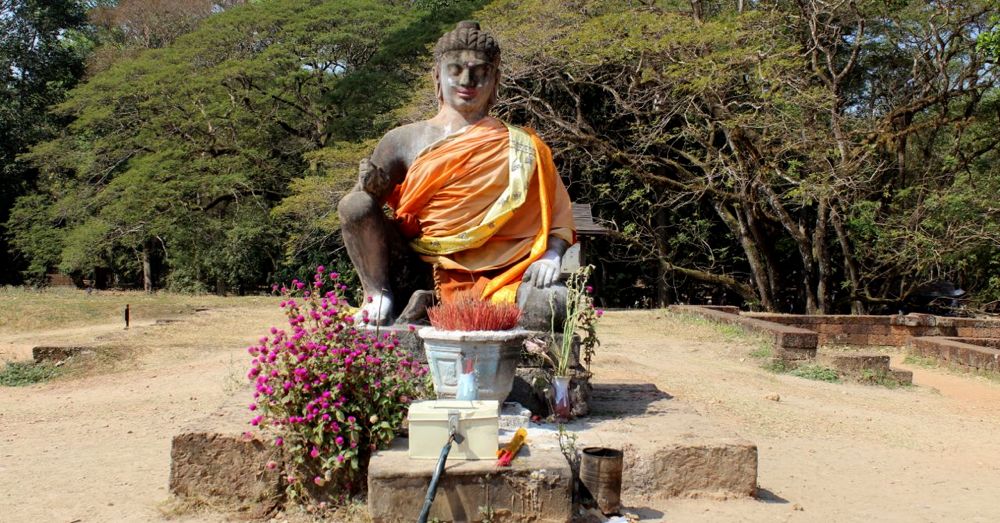Saturday, 17-01-2015. Day 150.
Among the Ruins of Angkor
I know what you're all thinking ... what happened to day 149? Well, we didn't do too much that day. We did meet up with another world-traveling family we'd met through Facebook, Mike and Amy of Worldschool Adventures and their two boys. We went to lunch and hung out together for most of the day talking travel, our plans for the future, the places we've been, and the places we were going. It was a pleasant day, and our girls liked hanging out with other kids for a little while.
Into Angkor Archaeological Park
Angkor Wat may be the best-known temple in Cambodia, but it is just a small part of the whole Angkor Archaeological Park (a UNESCO World Heritage Site), which covers something like 400 square kilometers. A lot of people, including many news outlets, inaccurately refer to the whole region as Angkor Wat.
We'd arranged a tour with Sen, our tuk tuk driver from Thursday's adventure, to take us around the on what is known as the "Small Tour Circuit" of Angkor for $15. He picked us up at 8:30 a.m. so we could get our passes first thing in the morning.
Angkor Park Passes
The first stop on any tour of Angkor Archaeological Park is the main park office so you can get the tickets that allow you to visit the wats inside the park.
We opted for the 3-day pass ($40 each), which allowed us to visit the the park on any three days during the seven days. Each ticket is personalized, and to get yours, you queue up and shuffle ahead until you get to the front, where you get your picture taken. We later learned this was to prevent scalping and to keep you from re-selling your ticket to another tourist.
Children under 12 get into the park and the wats for free, which is nice. But Frankie is almost 5'6", towering over most Khmer women and men, so we had to carry her passport with us to prove she was only 11. We got a lot of unbelieving looks that turned to astonishment when they checked her age.
Once we had our tickets, we met up with Sen and we zoomed along Charles De Gaulle Road into the park. Angkor Wat is the first wat most people come to when they enter the park from the south (Siem Reap is only a few kilometers away in that direction), and as we drove by Sen told us we'd swing back to Angkor Wat closer to sunset because it looked better then.
South Gate
Our first destination was Bayon, a temple inside of Angkor Thom, a large walled city of ruins just to the north of Angkor Wat. It means something like Great City, and it was the ancient capital of the Khmer built by Jayavarman VII (well, his people, anyway) starting in the 12th century after he kicked the stuffing out of the Cham invaders. At least that's one version of the story.
Angkor Thom is nine square kilometers surrounded by a moat, and there are five gates that allow access to the inside of the city—West Gate, North Gate, Victory Gate, Gate of the Dead (also known as the East Gate) and the South Gate.
Each gate can be reached after crossing a bridge over the city moat. Most people enter Angkor Thom through the South Gate. All the gates are pretty narrow and traffic builds up on either side during peak hours.
Bayon
Bayon is a temple at the center of Angkor Thom. It's a Buddhist temple also built by Jayavarman VII (he converted the whole country from Hinduism to Buddhism when he took over) and served as the state temple under his rule. Bayon once had 49 towers, each with a four giant faces, one looking out to each of the four compass points. Only 37 of these towers remain, but with those and some other, smaller towers around Bayon, the total face-count is more than 200.
But who's face is it? Some say it's a the face of the enlightened being Loksvara, but others think it's a combination of Buddha and Jayavarman VII himself. In any case, no matter where you go in Bayon, someone's looking at you.
Bayon, like some of the other popular temples, was quite crowded. There's a long, straight wall entirely covered in a carved mural that shows off some of Jayavarman VII's achievements, and there were so many people here it was hard to view.
Baphuon
From Bayon, we walked over to Baphuon, another temple inside the walls of Angkor Thom. Baphuon was built about 100 years before Bayon was started and is dedicated to the Hindu god Shiva. Compared to some of the other wats, Baphuon has only recently been restored.
Anyone under 12 couldn't climb this one because the steps up were really steep. I would argue that anyone over 65 shouldn't climb it either, based on how many people I saw having trouble as I climbed up to the top. The views from the top are pretty amazing, though.
Once I climbed back down, we walked out to the main road that runs through Angkor Thom and walked to the Terrace of the Elephants.
Terrace of the Elephants
The terrace itself, also built by Jayavarman VII (who is said to have used it, allegedly, as an audience chamber of some kind for the royal palace Phimeanakas that once stood behind the terrace), is a 300-meter long wall that's 2.5 meters tall. It's so named because it has elephants on it. Near the north end of the Terrace of the Elephants, we found the sort of creepy but interesting Terrace of the Leper King.
Terrace of the Leper King
This terrace was named after a statue that was found there, but it's unknown who the statue represents. Plenty of people have opinions, though. It could be the Angkorian god of wealth or an ancient king of Angkor who suffered from leprosy or Yama, the Hindu god of death. Some say when it was found, it was covered with lichen, so it looked like someone who had leprosy. There are a lot of mysteries about the symbolism and architecture of Angkor, and this is just one of them.
And then it was time to leave Angkor Thom. We met up with Sen (the tuk tuk drivers are very adept at finding their clients) and we zoomed out of the Victory Gate.
Victory Gate
Victory Gate is very similar to the South Gate, but it leads straight to the royal palace, the all-but-destroyed Phimenakas. The gate is a major thoroughfare out of Angkor Thom, and it, like the South Gate, can get pretty busy.
Chau Say Tevoda
Chau Say Tevoda is a small temple, built after Angkor Thom, in the style of Angkor Wat. We didn't learn much about this one, but it was kind of cute.
Thommanon
Right across the road from Chau Say Tevoda, you can find Thommanon, which was built after its nearby neighbor. This was one of our favorite temples. It was small and relatively secluded, so it was easy to get explore at our leisure. The girls enjoyed running (Temple Running) along its ledges and cool, dark hallways. We ended up visiting it twice.
Ta Keo
We stopped by Ta Keo, which was currently being renovated. A number of tourists had fallen off of it in recent years and Sen advised us against climbing it.
Ta Prohm
Ta Prohm is better known as the "Tomb Raider Temple," which is what all the locals call it. This is the second most famous temple in Angkor (after Angkor Wat). It was visited by Lara Croft in the first Tomb Raider movie, a fact the people here are really proud of. There are a lot of Tomb Raider references in town—mainly custom-made cocktails in some of the bars on Pub Street.
It is also famous for having the huge trees (Tetrameles nudiflora) overgrowing its stone walls, making it one of the more iconic temples in Angkor. The temple is not in the best shape, and when we visited a good portion of it was off limits as crews worked at restoration. But despite its crumbling condition (or perhaps because of it), the temple was a pretty spectacular sight.
There's also something about the temple that makes people forget how to read or even comprehend simple pictograms.
Angkor Wat
And then came time to visit the most famous temple in Angkor, Angkor Wat. Sen drove us around to the east side of the temple and dropped us off, telling us to meet him on the other side. We walked along a forested road for a little while until we rounded a corner and saw some monkeys (eek!) playing in the road and the five spires of Angkor Wat in the distance.
The walk to the temple isn't that long, but it's still amazing to watch the details emerge as you walk up the road to the gate right in front of it. It's an impressive structure, both from a distance and up close.
One of the walls along Angkor Wat is a huge mural that's called Churning of the Sea Milk, which is the story of how the naga king Vasuki was used by gods and demons to churn the ocean of milk for 1,000 years, eventually releasing immortality.
After you've seen the sea milk being churned and you pass through the long, straight halls that make up the outer wall of Angkor Wat, there's a narrow grassy strip that leads to the central structure, which is the 5-towered building so often seen in pictures. The steps to get up into the towers are pretty steep.
Once inside the inner walls, there are a lot of hallways to explore. It's still an active temple, so every so often you'll round a corner and come upon someone lying in front a a Buddha statue in the hallway.
You can also climb up another set of steep, narrow steps to go inside one of the four towers (the north east one, I think). I believe this was an active part of the temple people used for worship. You had to be more than 12 to go up, you couldn't take photos, you were limited to 15 minutes, and the lines were long, so we skipped that.
After exploring many hallways and what looked like a throne room of sorts with recessed pits, we decided it was time to leave. We dodged the crowds that filled the wide path back to the road and across the moat where we met up with Sen and headed back to the hotel. It had been a long day of exploring temples, and we were pretty tired.

Tom Fassbender is a writer of things with a strong adventurous streak. He also drinks coffee.


























